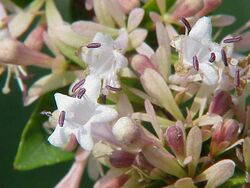Biology:Linnaea chinensis
| Linnaea chinensis | |
|---|---|

| |
| Scientific classification | |
| Kingdom: | Plantae |
| Clade: | Tracheophytes |
| Clade: | Angiosperms |
| Clade: | Eudicots |
| Clade: | Asterids |
| Order: | Dipsacales |
| Family: | Caprifoliaceae |
| Genus: | Linnaea |
| Species: | L. chinensis
|
| Binomial name | |
| Linnaea chinensis | |
| Synonyms[1] | |
|
List
| |
Linnaea chinensis, commonly known as Chinese abelia, is a species of flowering plant in the honeysuckle family Caprifoliaceae. It is a semi-evergreen, densely branched shrub with dark green foliage.
Taxonomy
It was described by Robert Brown in 1818,[2] and transferred to the genus Linnaea in 1872,[1] although this move was not widely accepted until 2013.[3]
Description
It is a compact deciduous shrub[4] with reddish stems and glossy, small leaves that become reddish-brown before autumn. Its simplified-form flowers are funnel-shaped, white, and its pink sepals remain long after flowering. As long as the plant continues to make new growth during the summer, it will continue to flower. It is one of the most cold-resistant species within the genus.
Distribution and habitat
The plant is found in south-central China and south-eastern China, as well as Taiwan, Vietnam, and the Ryukyu Islands.[5][6]
Linnaea chinensis is widely cultivated as an ornamental garaden plant.[7] Under the synonym Abelia chinensis, the cultivar 'China Rose'[8] has gained the Royal Horticultural Society's Award of Garden Merit.
References
- ↑ 1.0 1.1 1.2 "Linnaea chinensis (R.Br.) A.Braun & Vatke". Plants of the World Online. Royal Botanic Gardens, Kew. https://powo.science.kew.org/taxon/urn:lsid:ipni.org:names:148547-1. Retrieved 2018-01-22.
- ↑ "The Plant List: Abelia chinensis R.Br.". Royal Botanic Gardens, Kew and Missouri Botanic Garden. 2013. http://www.theplantlist.org/tpl1.1/record/kew-2609453. Retrieved 21 May 2016.
- ↑ Christenhusz, Maarten J.M. (2013). "Twins are not alone: a recircumscription of Linnaea (Caprifoliaceae)". Phytotaxa 125 (1): 25–32. doi:10.11646/phytotaxa.125.1.4.
- ↑ "Abelia chinensis". Royal Horticultural Society. https://www.rhs.org.uk/Plants/1/Abelia-chinensis-R-Br/Details. Retrieved 20 December 2017.
- ↑ http://powo.science.kew.org/taxon/urn:lsid:ipni.org:names:148547-1
- ↑ Qiner Yang & Sven Landrein. "Abelia chinensis". Flora of China. Missouri Botanical Garden, St. Louis, MO & Harvard University Herbaria, Cambridge, MA. http://www.efloras.org/florataxon.aspx?flora_id=2&taxon_id=200022258. Retrieved 10 October 2012.
- ↑ E.g., "Abelia chinensis R. Br.". The Royal Horticultural Society. http://apps.rhs.org.uk/plantselector/plant?plantid=4353. Retrieved 10 October 2012.
- ↑ RHS Plant Finder 2017. United Kingdom: Royal Horticultural Society. 2017. pp. 960. ISBN 978-1907057779.
Wikidata ☰ {{{from}}} entry
 |

